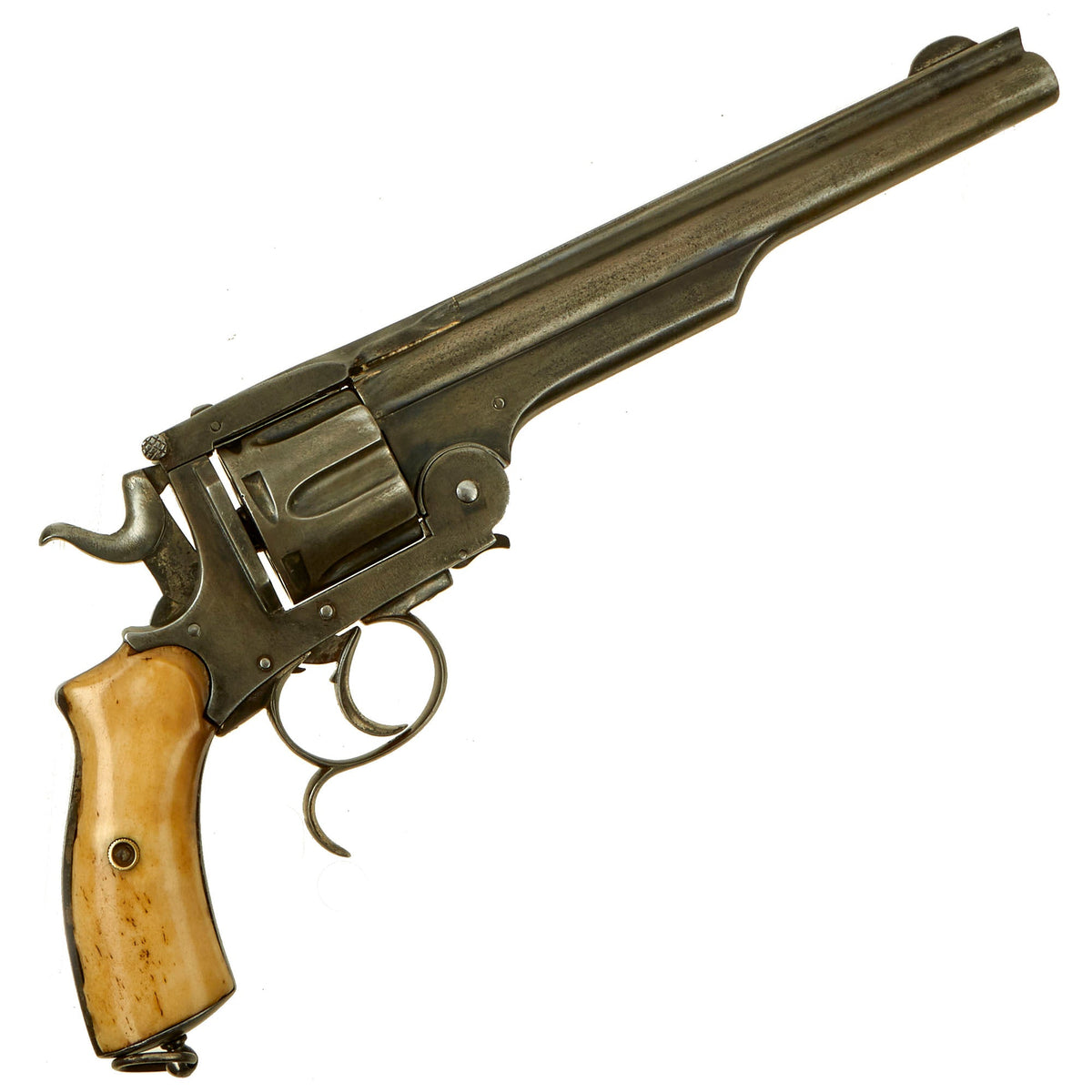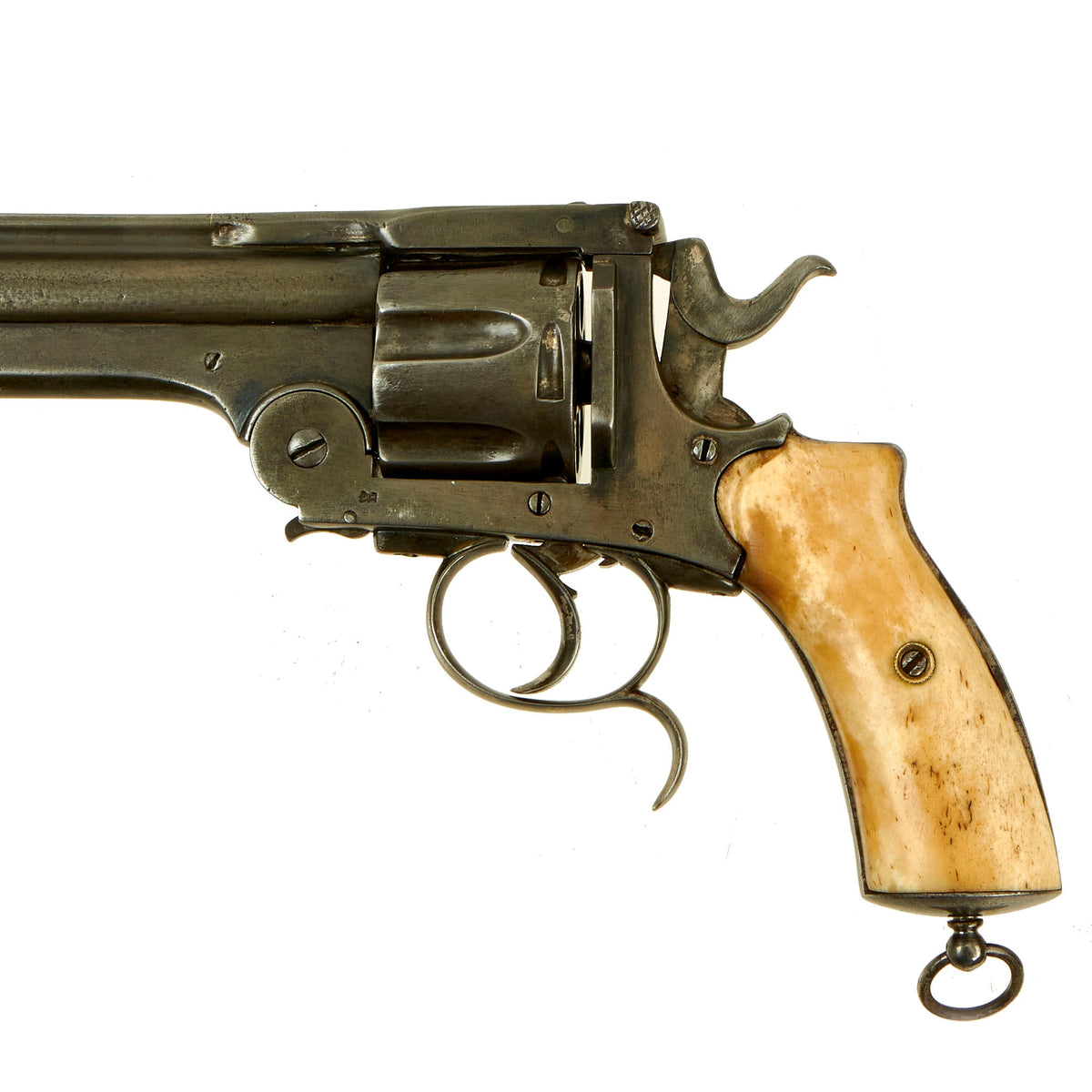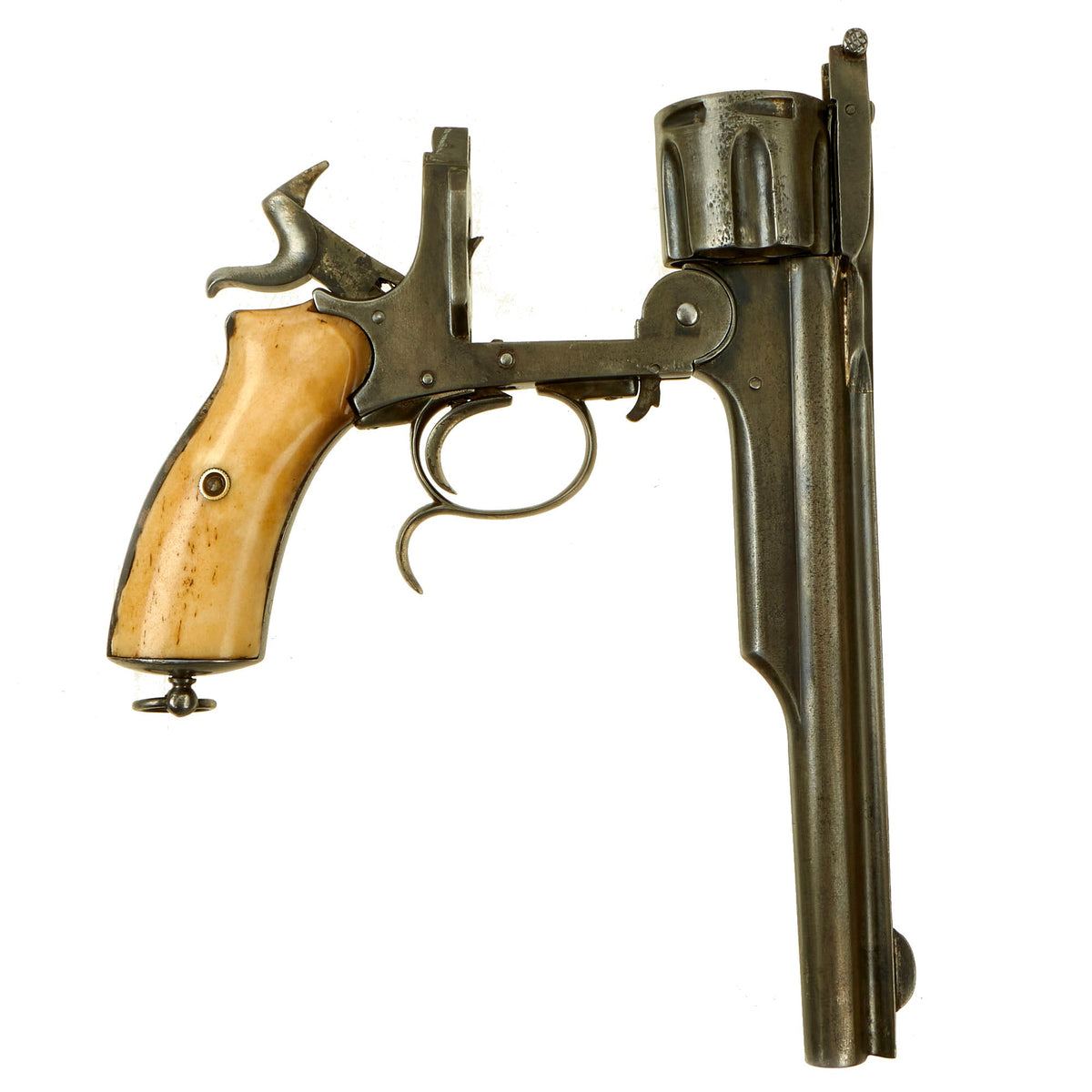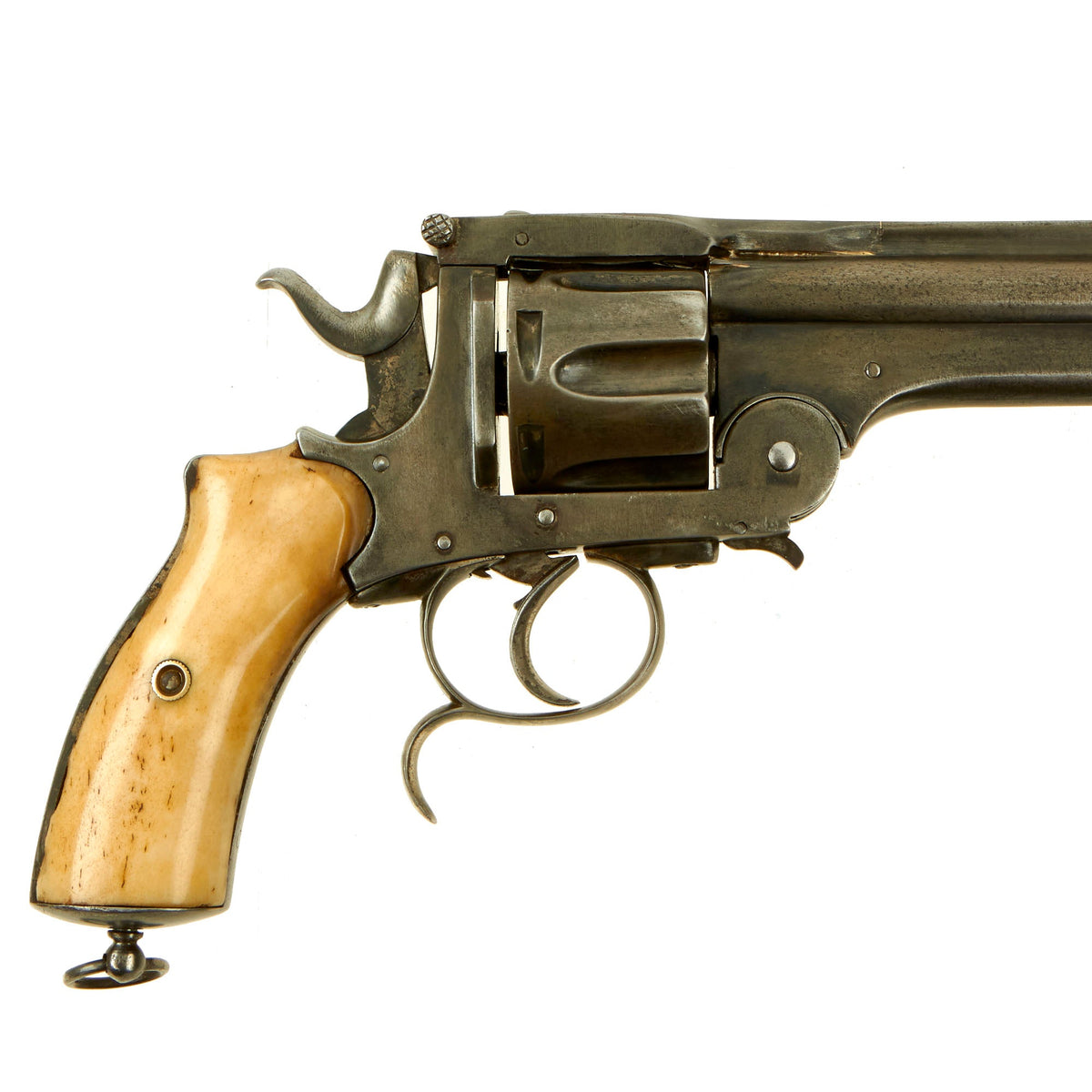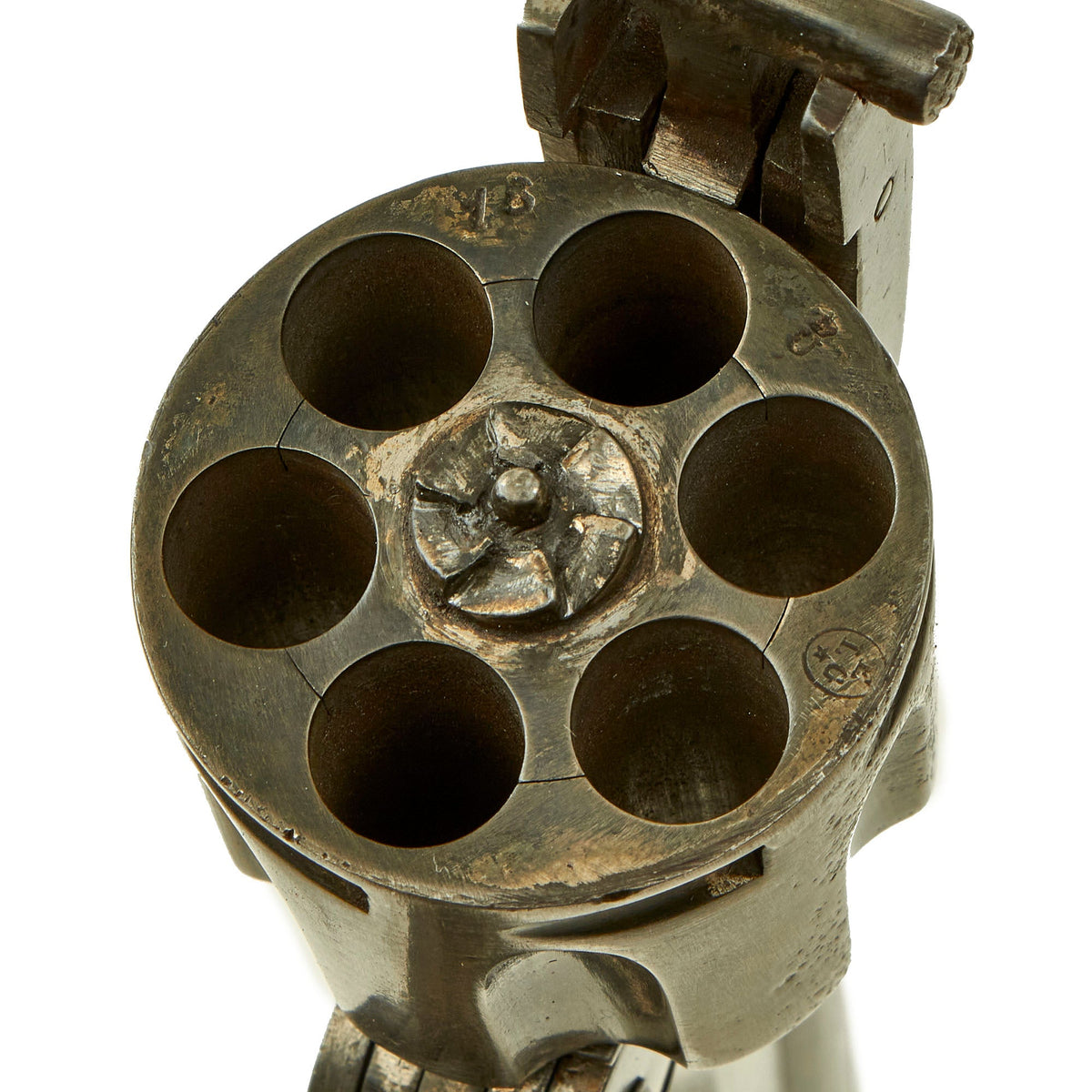Original Belgian Smith & Wesson Model 3 Revolver Double Action Copy for the Russian Contract Market Original Items
$ 1.495,00 $ 373,75
Original item: Only One Available. Here we have a very nice Belgian made Copy of the Classic Smith & Wesson “Russian” Model 3 Revolver, with some great aged stag or horn grips. Additionally, it is in DOUBLE action, while the original model 3 revolvers were single action only. Definitely an interesting revolver here with some fantastic research potential!
In 1870/71 General Alexander Gorloff of the Imperial Russian Embassy had visited Smith & Wesson, and placed an order for 41,000 units. In 1872 Grand Duke Alexandrovich also visited the factory to great accolades, resulting over the following years the Imperial Russian Army ordering over 130,000 of this Model Revolver in total.
However, the Russian government was across the globe from Smith & Wesson, which meant additional cost and time waiting for revolvers. Shipments could also be disrupted by weather, war, or other issues. This also meant that it was unlikely S&W would be able to enforce litigation, so Russia started contracting European companies to produce the design. In addition, S&W had also angered the Russians by selling arms to Turkey and Japan, enemies of Imperial Russia. So, in 1876 the Russians decided to move No. 3 Russian revolver production from S&W in America to Ludwig Loewe in Berlin.
With news of this spreading throughout Europe, other makers looked to grab a portion of the Russian contract market, so various companies across the continent started producing their own copies, which were sold domestically if they were unable catch Russia’s interest. This example is not maker marked, but it bears Belgian proof marks on various components, including the E / L G / * in an oval used by Liège, Belgium on the back of the barrel. There is no “crown” on this marking, which was added in 1892, which also verifies that this revolver is a Pre-1899 Antique according to Federal Law.
As there are no Russian markings on the revolver, this was definitely a private purchase example, probably sold domestically, or possibly even exported. The lack of markings was most likely to help obscure who manufactured it, so that they could not be traced should it end up in the United States and Smith & Wesson lawyers decided to take action. Russian contract guns would have Russian acceptance markings, and usually were marked in Cyrillic across the top of the barrel rib.
The revolver looks to have been at least partially nickel plated at some point, which we can see when we removed the grips. There are some numbers stamped on the frame, but nothing we can see that looks like a serial number. There is a prominent CROWN / GS marking, which could be a maker mark. In addition to the Liège proof on the back of the cylinder, there is the number 16 and a CROWN / U proof. There is also a CROWN / L Proof on the left side of the frame under the cylinder.
The revolver is in good condition, with a lot of wear overall, and definitely looks to have seen long service. The grips have a lovely aged look, and look to be custom carved antler, horn, or possibly even bone. They definitely have a lovely look, though they are a bit undersized for the grip frame. The bore shows clear lands and grooves, with some areas of oxidation, especially near the cylinder. The frame brakes open correctly, and the ejector presents, however the tab on the hinge that engages it does not stay in place unless held there. We assume that some internal spring is broken or missing.
The revolver action unfortunately has some mechanical issues, so it does not function reliably in single or double action. The hand often fails to engage the cylinder ratchet, unless the cylinder is pre-rotated a bit. It also does not work in double action unless the hammer is first pulled back to the first click. Unfortunately parts and diagrams for this revolver are not available, as the internal workings differ substantially from an original Model 3.
Despite the great production, “Russian Model” revolvers are very rare and hard to find today, even the copies made in Europe. A very interesting Belgian made DOUBLE ACTION example, completely honest, ready for display!
Specifications:
Years of Manufacture: circa 1876-1880
Caliber: .44 Russian
Ammunition Type: Centerfire Cartridge
Barrel Length: 7 inches
Overall Length: 12 3/4 inches
Action: Double / Single Action
Feed System: 6 Shot Revolver
History of the Smith & Wesson Model 3
The Smith & Wesson Model 3 was a single-action, cartridge-firing, top-break revolver produced by Smith & Wesson from circa 1870 to 1915.
It was produced in several variations and sub-variations, including both the “Russian Model”, so named because it was supplied to the military of the Russian Empire (41,000 No. 3’s were ordered in .44 caliber by the Imperial Russian Army in 1871), and the “Schofield” model, named after Major George W. Schofield, who made his own modifications to the Model 3 to meet his perceptions of the Cavalry’s needs. Smith & Wesson incorporated these modifications into an 1875 design they named after the Major, planning to obtain significant military contracts for the new revolver.
The S&W Model 3 was originally chambered for the .44 S&W American and .44 Russian cartridges, and typically did not have the cartridge information stamped on the gun (as is standard practice for most commercial firearms). Model 3 revolvers were later produced in an assortment of calibers, including .44 Henry Rimfire, .44-40, .32-44, .38-44, and .45 Schofield. The design would influence the smaller S&W .38 Single Action that is retroactively referred to as the Model 2.
Fast Shipping with Professional Packaging
Thanks to our longstanding association with UPS FedEx DHL, and other major international carriers, we are able to provide a range of shipping options. Our warehouse staff is expertly trained and will wrap your products according to our exact and precise specifications. Prior to shipping, your goods will be thoroughly examined and securely secured. We ship to thousands clients each day across multiple countries. This shows how we're dedicated to be the largest retailer on the internet. Warehouses and distribution centres can be located throughout Europe as well as the USA.
Note: Orders with more than one item will be assigned a processing date depending on the item.
Before shipping before shipping, we'll conduct a thorough inspection of the items you have ordered. Today, the majority of orders will be delivered within 48 hours. The delivery time will be between 3-7 days.
Returns
The stock is dynamic and we cannot completely manage it because multiple stakeholders are involved, including our factory and warehouse. So the actual stock may alter at any time. It's possible that you may not receive your order once the order has been made.
Our policy is valid for a period of 30 days. If you don't receive the product within 30 days, we are not able to issue a refund or an exchange.
You can only return an item if it is unused and in the same state as the day you received it. You must have the item in its original packaging.
Related products
Uncategorized
Australian WWII Owen MK1 Machine Carbine SMG Custom Fabricated Replica with Sling Original Items
Uncategorized
Armored Burgonet Helmet & Polearm from Scottish Castle Leith Hall Circa 1700 Original Items
Uncategorized
Uncategorized
Uncategorized
Uncategorized
Uncategorized
Uncategorized
Uncategorized
Angolan Rebel 1970s era 60mm Inert Display Mortar from Angolan Civil War Original Items
Uncategorized
Uncategorized
Uncategorized
Uncategorized
Band of Brothers ORIGINAL GERMAN WWII Le. F.H. 18 10.5cm ARTILLERY PIECE Original Items
Uncategorized
Uncategorized
Uncategorized
Uncategorized
Uncategorized
